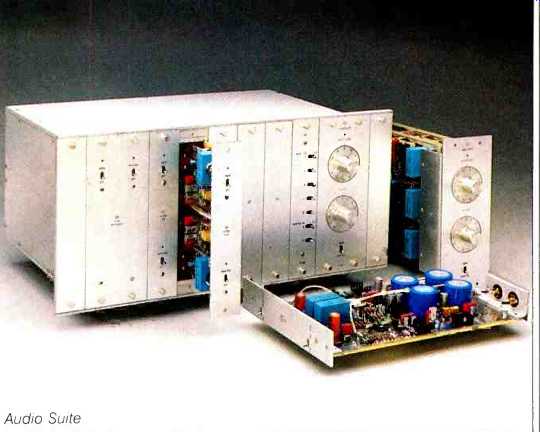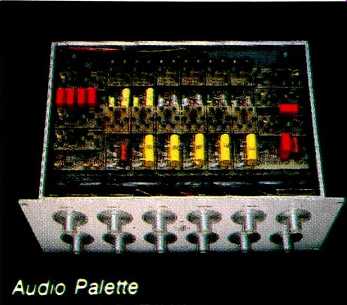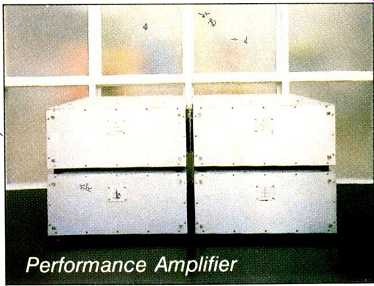FIRST-STRING INSTRUMENTS

In every product category, there is always a small group of items considered outstanding for their high quality, and sometimes one product is incontestably the very best, the exemplar that sets the standards by which all similar products must be judged. I freely admit that some of the differences in quality among products of such high pedigree are indeed subtle.
Nonetheless, for some months now I have been evaluating the performance of the new audio equipment from Cello, Ltd., and I can say without reservation that the sonic sophistication, advanced circuit topology, and uncompromised construction found in this line surpass anything I've ever encountered. Yes, this is certainly a strong statement. What follows will, I hope, convey why I formed this opinion.
As you probably know, some time ago Mark Levinson founded Cello, Ltd., located in New Haven, Conn. He is president and CEO; his vice president of engineering is the remarkable Tom Colangelo, who was with Mark in his original company. Tom is a brilliant and innovative engineer who, over the years, has given the audio world some landmark designs which have established new standards of sonic excellence. Tom has designed the Cello components in keeping with Mark's basic philosophy. It has three main elements: The Audio Palette, an elaborate control/equalizer system; the Audio Suite, an advanced mainframe-type preamplifier using modular components, and the Performance Amplifier, a monoblock unit, each section of which has a separate power supply.
The Audio Suite is rack-mountable, measuring 19 inches wide, 9 inches high, and 12 inches deep. It is of heavy aluminum bar and plate construction, precisely assembled with machine screws. This construction method is costly, but it offers great rigidity, especially compared to the usual sheet-metal construction of most convention al preamps. The mainframe has an electrical input for d.c. and an elaborate signal bus system. It has 10 "bays," each of which can be covered by a metal dress plate when not in use.
By removing the dress plates, various modules can be installed. The unique method of securing the modules ensures electronic integrity: Removing a plate on the lower back portion of the mainframe reveals a Delrin plate with 10 vertical holes at the rear of each bay. After a module is inserted in the bay, screws are threaded through the Delrin, then through threaded, quarter-inch square-section, solid copper bus bars, and thence into threaded holes in the module itself. There are two ground buses, one +30 V and one-30 V, and six audio buses. The audio buses can be used in various ways, depending on module function. Three stereo buses can be used or, in professional recording applications, two stereo buses plus two mono cue buses. Due to the bus system, there is no conventional wiring in the Audio Suite. The master power supply provides ±30 V at 8 amperes regulated d.c. A special trip loop provides protection against over-voltages and short circuits. The Master Supply can simultaneously feed the Audio Suite and the Audio Palette; it can (and should) be located a considerable distance from these units. Since the Master Supply provides double regulation, a special ad vantage accrues: The second regulator doesn't have to deal with significant ripple voltage and ripple current.
The Audio Suite's modular design provides great flexibility so that facilities can be tailored to individual needs.
Since each module has a considerable amount of internal volume, a large number of parts can be accommodated; such space also permits the use of larger film capacitors. The Audio Suite I have been using has the P101 moving-coil phono module, which has a great many polycarbonate capacitors, highly refined circuit topology, and separate power regulators for each channel. Uniquely, for reduction of hum and noise, the entire module is enclosed in a mu-metal case. The line section in this Audio Suite is a P200 module, which has switchable options for grounding, input impedance, and gain (with a total of 24 dB available). I use the P200 for CD and R-DAT play back. Both the P101 MC phono module and the P200 line-stage module have small toggle switches which will provide output to the main output or monitor. Another module in the Suite I have been using is the B200. It provides five stereo pairs of RCA inputs, with toggle switches making pairs four and five capable of monitor output.
This module is connected via a resistor through the audio buses to the P301 summing amplifier output module. The P301 has a calibrated output level and balance control and a toggle switch for main out or monitor; record outputs are available on the rear of the module, and output impedance is 5 kilohms.
The "P" modules are equipped with push/pull Class-A circuitry. In addition to the double regulation afforded by the Master Supply, they also have separate regulators for each channel pro viding ±25 V d.c.
All modules may be mixed, due to the common bus/summing amplifier approach. In professional applications, this has many advantages. The Audio Suite operates in a balanced input/out put configuration. Special Swiss-made, three-pin Fischer connectors are used with "Cello Strings," which are inter connect cables of Litz construction using three-conductor, oxygen-free cop per wire and Teflon dielectric. XLR connectors can be fitted for professional use. The "P" modules are fitted for Fischer plug balanced inputs, and the P301 module is similarly equipped for balanced output. For connection to unbalanced consumer components, various adaptors are available. The Audio Suite has delay circuits to avoid on/off switching thumps.
Future modules for the Audio Suite will include A/D and D/A converters, an FM tuner, power amplifiers, special purpose remotely controllable modules, and others. Without question, the Audio Suite is a unique preamp that offers freedom from obsolescence and delivers awesome performance.
The Cello Audio Palette is a similarly unusual component, of a design heretofore unavailable to audiophiles. Measuring 19 inches wide, 7 inches high, and 12 inches deep, it is an incredibly complex equalizer and control unit and an engineering tour de force. There are nearly 6,000 parts in an Audio Palette, including 48 discrete Class-A amplifiers. All of these components and parts are on 55 circuit boards mounted in seven levels! Although this complexity flies in the face of "less is more," I can assure you that the Audio Palette is sonically transparent; in fact, the complexity is necessary for optimizing each stage for best performance. A large number of high current stages are used to reduce noise and distortion when driving low-impedance filter, interstage, and output loads.
Filter characteristics have been optimized for time-delay aberrations; thus, the equalization is virtually free of ringing and phase-shift errors. The filters were designed by Richard S. Burwen, a brilliant engineer who is preeminent in the field of filter design and equalization. In his design for the Palette, he employed minimum-phase, 6-dB/octave roll-off filters, with slight modifications at the 15-Hz and 25-kHz extremes. The filters overlap rather broadly, except for those which are centered at 500 Hz and 2 kHz. This clever design affords easy-to-effect changes, and even very small adjustments are quite perceptible. Filter center frequencies are at 15, 120, and 500 Hz and at 2, 5, and 25 kHz, adjustable via 59-position controls.

--------Audio Palette
The Audio Palette uses the same bar and plate construction as the Audio Suite. As noted, it too is powered from the Master Supply, with double-regulated ±30 V d.c., although there is further internal regulation. The Palette also operates in a balanced input/out put configuration with Cello Strings and three-pin Fischer connectors.
The Palette's 12 controls are all made of milled brass and are calibrated in steps. The top row has left and right input level controls, then a phase reversal switch, and then a three-position "Equalization" switch. The latter can put the Palette into the "Out" mode, with no equalization and with unity gain, or into the "In" mode, which activates the EQ and balance controls.
There is also a "Blend" position on this switch, which puts the unit into mono below 40 Hz. "Output Level," at the far right of the top row, is really something special-a 59-position rotary control with stereo tracking within 0.02 dB in increments of 1 dB! Each element of the control is custom-made with platinum/palladium alloy contacts (the same as are used in helicopter rotors) which ensure practically unlimited duty cycling, and with gold-plated circuit boards.
The Palette offers a total of 26 dB of gain from input to output, so direct drive of the Palette is possible from Compact Disc players or R-DAT recorders, AM/FM tuners, and analog tape recorders. A power amplifier card will be forthcoming, and speaker barrier-strip terminals are already on the rear of the Palette. For those who have limited space or who prefer a small audio system of ultra-high quality, this is the answer.
The Palette is designed to be inserted between the Audio Suite and the Performance Amplifier in balanced configuration, with the Audio Suite's output level control set to "0" and its balance control in the center position.
In this mode, the Palette's "Output Lev el" serves as the master level control for the entire system, controlling input level adjustment and balance, polarity reversal, and equalization.
The final link in the Cello system is a pair of the Performance Amplifiers, monoblock units, and their matching separate power supplies. Each chassis measures 17 1/2 inches wide, 7 3/4 inches high, and 17 inches deep; in the aggregate, they weigh over 250 pounds. The amplifier's output power transistors are mounted on electrically conductive heat-sinks, forming "tunnels" through which air is forced by two ultra-quiet fans which do not intrude even on triple pianissimo pas sages of music. Because insulators are not used, the power devices work more efficiently.
Cello points out that conventional amplifiers use capacitive-input power supplies which waste most of the a.c. cycle and need large transformers to supply high peak currents. In addition, capacitive-input supplies are extremely sensitive to a.c. line fluctuations. In contrast, Cello tells me, the Performance Amplifier's power supply has dual-choke inputs, which utilize the en tire a.c. waveform, affording a high power factor and more efficient use of the a.c. line current. Other benefits of dual-choke input include additional filtering and energy storage, less stress on capacitors, and better balance of charging currents, which helps to maintain dynamic balance of the ground point. The Performance Amplifier uses forty 250-watt bipolar power transistors per channel and, as you might imagine, this produces a whop ping output current. While measurement of current of this amplifier is somewhat limited by the a.c. line, the unit is capable of 40 amperes continuous and 60 amperes on pulse, and it has a peak output of 200 amperes! With vanishingly low distortion, the Performance Amplifier is rated at 200 watts into 8 ohms and 400 watts into 4 ohms, with clipping at about 750 watts.
It can drive 1-ohm loads easily at roughly 1,600 watts. Operation is Class A up to 100 watts and thereafter is Class AB. The Performance Amplifier uses balanced inputs via three-pin Fischer connectors and Cello Strings.
Well, the Cello audio system comprises a formidable group of high-tech, ultra-sophisticated components. Each is built to the highest standards of quality with the best commercially available parts and with some specialized parts made exclusively for Cello.
Products of this caliber are necessarily expensive-but there is still such a thing as value for money. These three units as a package cost $33,000. They can be bought separately and will certainly work well with other equipment, but they are made for each other and are synergistic in total performance.
The big question is, how well does this gilt-edge equipment perform? Is it worth the megabucks? In matters of sonic performance, the Cello equipment is truly incredible. I teamed the three units with two speaker systems:
An updated version of the Duntech Sovereigns, which now have a new crossover permitting bi-wiring or bi-amplification, and B & W 801 Matrix units, which are just now beginning to be available in the U.S. I used Path Litz OFC speaker cables to bi-wire the Sovereigns to double outputs on the Performance Amplifier. For source material, I used a Sony CDP-705ESD CD player, connecting its coaxial digital output port to a Denon DAP-5500 digital processor/preamp. Then I ran its D/A converter output via Cello Strings into the P200 line input module on the Audio Suite. I also ran a Sony DTC 1000ES R-DAT recorder through the Denon processor and on to the Audio Suite. I fed my Sony PCM-F1 digital processor into the high-level B200 module on the Audio Suite, and did the same for my Ampex ATR-100 open-reel recorder. Phono signal was provided by a VPI HW-19 Mark 2 turntable with SME's Series V arm and a Cello Chorale MC phono cartridge. I used virtually the same setup with the 801 Matrix speakers, except that I did not use bi-wiring.

------ Performance Amplifier
If I had to name the characteristics of the Cello electronics that immediately made me enamored of the system, they would have to be its incredible impression of openness, spaciousness, and sonic transparency. This is apparently the result of the unbelievably clean response all across the audio spectrum. The ability of the Cello equipment to cleanly delineate complex musical passages is quite extraordinary. For instance, the battle scene in Richard Strauss' "Ein Heldenleben" on the London/Cleveland Orchestra CD is a densely orchestrated section with violent dynamics, yet the musical textures were clearly revealed-even those with the most subterranean bass. In the opening passages of the fourth movement of the Shostakovich Thirteenth Symphony, also on a Lon don CD, there is an awesome 31-Hz bass drum roll of tremendous weight.
On most systems, it sounds rather muddy and overly resonant. With the Duntech Sovereign/Cello combination, the drum roll was clearly articulated each stroke was distinct and clean.
Transient response was outstanding, with piano attacks absolutely crisp and never smeared. The snare drums, rim shots, and other percussion in Tom Jung's new DMP CD of The Thom Rotella Band were razor-sharp, with the Cello system explosive in its speed and accuracy of timbre.
Speaking of Tom Jung, he uses the Cello Audio Palette extensively in his recordings and employs other Cello electronics in his custom mixing con sole. The Palette and Suite are also used by Polygram, Atlantic, and RCA, to name just a few record companies, and by such prestigious mastering studios as Sterling Sound and Bob Ludwig's Masterdisk.
I literally gorged myself on all my favorite music when I first set up the Cello system. I am a confirmed Mahler junkie, and hearing his profundities and heaven-storming dynamics along with his sweet lyricism was an over whelming musical experience with this equipment.
Quite frankly, I've always been a bit down on equalizers, because most of them introduced unacceptable coloration of the music along with ringing and phase shift. However, the Audio Palette is a fascinating instrument, unlike anything I've ever used. It is in deed sonically transparent, utterly clean, and vastly useful in dealing with many of the ills and artifacts that affect recorded music. The Palette is quite efficient in taming high-frequency "glare" from early CDs and in obtaining a smoother frequency response. It is a God-given boon to vinyl records, which, because of cutting geometry and other constraints, are sometimes an affront to one's musical sensibilities.
The Palette is easy to use, if you have a good ear for music-just follow your natural instincts for good sound. Many recordings will "bloom" with only the most subtle changes in equalization.
Others may require more radical surgery, but it would be a rare recording that did not improve through the use of the Palette's magic knobs. It is very easy to love the Palette on short acquaintance. Play an organ recording that is deficient in the bass pedal, deftly manipulate the 15-Hz control for a few dB of boost, and your ears will appreciate the improvement. In short, the Palette can significantly expand and enhance the enjoyment of recorded music.
In spite of the potshots of those who sneer at high-end audio equipment and its big price tags, it sure is nice to know that if your ship ever comes in, such equipment is available to enrich your life.
(adapted from Audio magazine, Mar. 1988; Bert Whyte)
= = = =